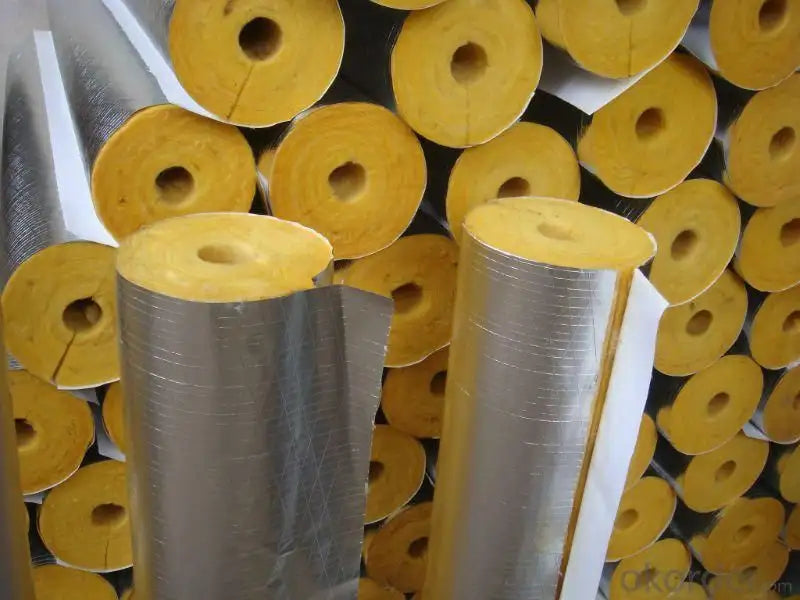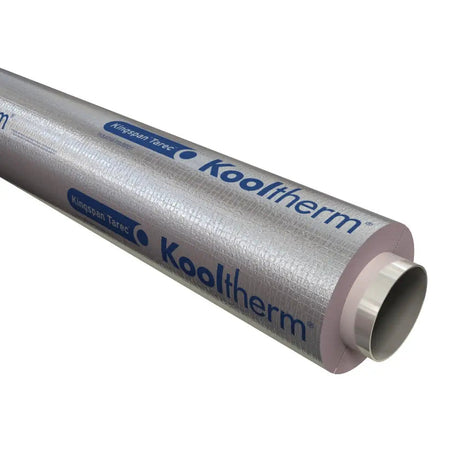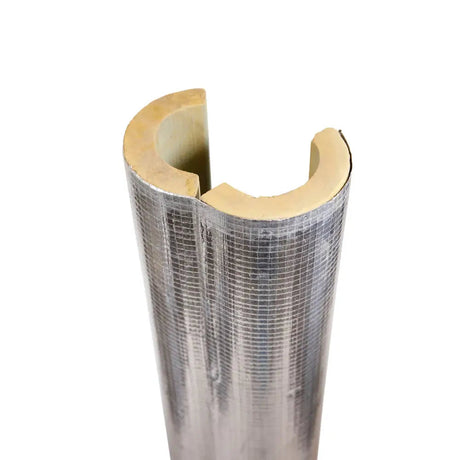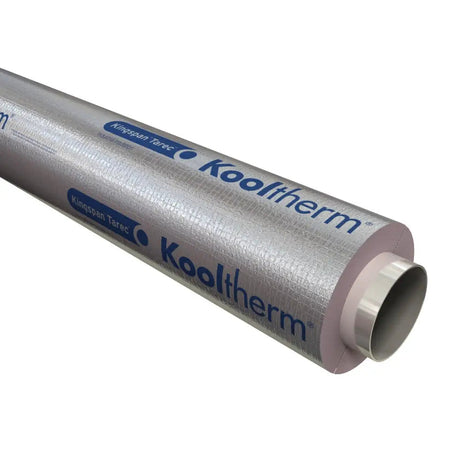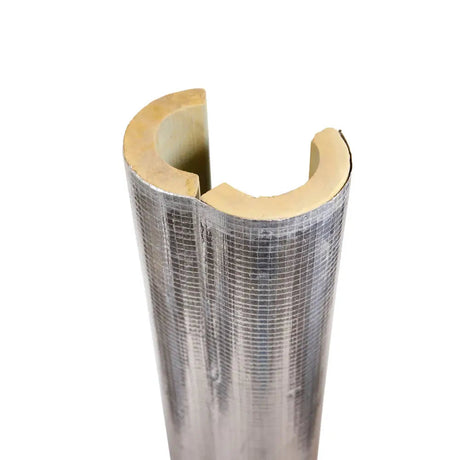Isover
Fiberglass Pipe Insulation / Lagging (Foil Covered) (1.2m)
From £605Unit price /Unavailable
Understanding Fibreglass Pipe Insulation
Fibreglass pipe insulation is a versatile and effective solution for maintaining temperature control in a variety of piping applications. This type of insulation is made from fine fibres of glass which are woven into a material that can be moulded around pipes. The primary purpose of fibreglass pipe insulation is to reduce heat transfer between the pipe and its surrounding environment. This ensures that the fluid being transported within the pipe stays at the desired temperature, reducing energy costs and improving efficiency. Fibreglass insulation is especially appreciated for its fire-resistant properties, making it a safe choice for many industries.
Fibreglass pipe insulation is a vital product that can be found across a number of major insulation manufacturers' product lines. For instance, Kingspan, under their Kooltherm range, offers a variety of fibreglass pipe insulation solutions designed to provide excellent thermal performance. Rockwool, Paroc, and Isover also manufacture fibreglass pipe insulation products that stand out for their durability, performance, and reliability. These products are developed with a focus on sustainability and energy efficiency, offering a wide range of insulation thicknesses to cater to the diverse needs of various industries.
The Value of Choosing Fibreglass Pipe Insulation
When choosing pipe insulation, the benefits of fibreglass are plentiful. Its high insulative properties are key to enhancing energy efficiency, thus contributing to cost savings and environmental sustainability. Moreover, fibreglass insulation is non-combustible, making it a safe choice in environments where fire safety is paramount. It also dampens noise, an added benefit in areas where noise reduction is necessary.
Given its diverse properties, fibreglass pipe insulation is favoured by a broad spectrum of professionals including contractors, engineers, and architects, who frequently specify these products in the design and construction of buildings. It's also widely utilised in industries such as HVAC (Heating, Ventilation, and Air Conditioning), oil and gas, and power generation, all of which require effective temperature control and noise dampening.
Maintenance of Fibreglass Pipe Insulation
In terms of maintenance, fibreglass pipe insulation requires minimal upkeep, which is one of its attractive features. However, regular inspections for any signs of wear and tear or water intrusion are advisable. While fibreglass insulation is moisture resistant, it's not entirely waterproof. Persistent moisture can lead to a reduction in insulative properties and potential mould growth. Therefore, ensuring the insulation remains dry and undamaged is key to maintaining its effectiveness and longevity.
Comparative Analysis of Fibreglass Pipe Insulation Brands
When assessing the various brands offering fibreglass pipe insulation, it becomes clear that the differences between them are relatively minor. Each brand, be it Kingspan's Kooltherm, Rockwool, Paroc, or Isover, strives to provide top-quality insulation solutions, and their products generally perform similarly in most applications.
Each brand, however, may have a slight edge in specific scenarios due to slight variations in the manufacturing processes or materials used. For instance, one brand's insulation may have marginally superior fire resistance, making it more suitable for use in environments where fire safety is critical. Another brand might excel in producing insulation with enhanced acoustic properties, which would be more appropriate for applications where noise reduction is a primary concern.
When it comes to pricing, it's important to understand that a higher price doesn't necessarily denote a superior product. The price variance between different brands or even within the same brand can often be attributed to differences in the length of the insulation provided. This can create a misconception that one product is more expensive than another, but in reality, the price per square metre or per metre might be very similar. Therefore, when comparing prices, it's crucial to consider the price per unit length or area, rather than the total cost of the product.
Frequently Asked Questions
-
What is fibreglass pipe insulation?
Fibreglass pipe insulation is a type of insulation material made from glass fibres. It is commonly used to cover and protect pipes, providing thermal insulation and preventing heat loss or gain.
-
How does fibreglass pipe insulation work?
Fibreglass pipe insulation works by creating a barrier of trapped air within its fibres. This trapped air acts as an insulator, reducing heat transfer and maintaining the desired temperature inside the pipes.
-
What are the benefits of using fibreglass pipe insulation?
Fibreglass pipe insulation offers several benefits, including energy savings, temperature control, condensation prevention, noise reduction, and protection against freezing. It also helps improve system efficiency and reduces environmental impact.
-
Is fibreglass pipe insulation fire-resistant?
Yes, fibreglass pipe insulation is typically manufactured to be fire-resistant. It has a high melting point and is designed to withstand high temperatures, providing an added layer of fire protection to the pipes it covers.
-
Can fibreglass pipe insulation reduce energy costs?
Absolutely. Fibreglass pipe insulation acts as a thermal barrier, preventing heat loss in hot water pipes and reducing heat gain in chilled water pipes. By minimizing energy transfer, it helps lower energy consumption, resulting in reduced energy costs.
-
What types of pipes can be insulated with fibreglass?
Fibreglass pipe insulation can be used on a wide range of pipes, including copper, steel, and plastic pipes. It is suitable for both hot and cold water systems, heating systems, and HVAC (heating, ventilation, and air conditioning) applications.
-
Is fibreglass pipe insulation easy to install?
Yes, fibreglass pipe insulation is relatively easy to install. It comes in pre-formed sections or rolls that can be cut and wrapped around the pipes. Adhesive tapes or bands are often used to secure the insulation in place.
-
How long does fibreglass pipe insulation last?
The lifespan of fibreglass pipe insulation can vary depending on factors such as environmental conditions and maintenance. However, with proper installation and care, it can last for many years, often exceeding a decade.
-
Does fibreglass pipe insulation require maintenance?
Fibreglass pipe insulation generally requires minimal maintenance. However, it's important to regularly inspect the insulation for any signs of damage, such as tears or water absorption. Damaged insulation should be repaired or replaced to maintain its effectiveness.
-
Is fibreglass pipe insulation resistant to moisture?
Yes, fibreglass pipe insulation is designed to be moisture-resistant. The glass fibres used in its construction are non-absorbent, preventing the insulation from becoming waterlogged. Moisture resistance helps maintain the insulation's thermal performance over time.
-
Can fibreglass pipe insulation help with noise reduction?
Yes, fibreglass pipe insulation can contribute to noise reduction by absorbing and dampening sound waves. It helps minimize the transmission of noise through the pipes, resulting in a quieter environment.
-
Is fibreglass pipe insulation eco-friendly?
Fibreglass pipe insulation is considered relatively eco-friendly. It is made from recycled glass and sand, which are abundant and renewable resources. Additionally, it helps reduce energy consumption, leading to a lower carbon footprint and decreased environmental impact.
-
Can fibreglass pipe insulation be used in outdoor applications?
Fibreglass pipe insulation can be used in outdoor applications, provided it is properly protected from direct exposure to sunlight and harsh weather conditions. Weather-resistant jacketing or protective coatings are typically used to shield the insulation from external elements.
-
What temperature range can fibreglass pipe insulation withstand?
Fibreglass pipe insulation is designed to withstand a wide temperature range. It can handle hot temperatures up to approximately 450°C (842°F) and cold temperatures as low as -40°C (-40°F), making it suitable for various industrial and commercial applications.
-
Is fibreglass pipe insulation suitable for high-pressure systems?
Yes, fibreglass pipe insulation is suitable for high-pressure systems. It provides not only thermal insulation but also helps prevent condensation, which is particularly important in high-pressure applications where moisture can cause corrosion or affect system performance.
-
Does fibreglass pipe insulation comply with building codes and regulations?
Fibreglass pipe insulation generally complies with building codes and regulations. However, it's essential to verify specific requirements and standards set by local authorities or regulatory bodies to ensure compliance for your particular application.
-
Can fibreglass pipe insulation be used in residential buildings?
Yes, fibreglass pipe insulation is commonly used in residential buildings. It helps improve energy efficiency, reduces heat loss, and provides comfort by maintaining consistent temperatures throughout the plumbing and HVAC systems.
-
What sizes are available for fibreglass pipe insulation?
Fibreglass pipe insulation is available in various sizes to accommodate different pipe diameters. Common sizes range from small pipes with a diameter of 15mm (0.6 inches) to larger pipes with a diameter of 200mm (7.9 inches) or more.
-
Is fibreglass pipe insulation resistant to pests and rodents?
Fibreglass pipe insulation is not inherently resistant to pests and rodents. However, when properly installed and sealed, it can help deter their entry into the building's infrastructure. Additional measures, such as using pest-proofing materials or techniques, may be necessary for comprehensive protection.

